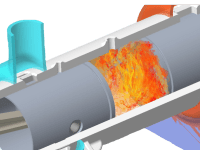The issue of climate change and the European initiative "Fit for 55" are focusing on the goals of efficiency and decarbonization in the future of mobility. This has sparked a significant interest in hydrogen as an energy carrier due to its ability to generate energy with low pollutant emissions.
2HOPE is an innovative opposed-piston engine that utilizes hydrogen in a combustion as its primary fuel source. By using the power of hydrogen, the 2HOPE engine offers numerous advantages, including reduced emissions, high efficiency, and a sustainable supply chain. Furthermore, it is expected to be a more cost-effective solution compared to the transition to electric vehicles since it leverages the existing worldwide supply chain.
The 2HOPE engine is a two-stroke design that originated in 1900. It features two pistons that share the same combustion chamber, while the intake and exhaust valves are positioned far apart and are operated by the pistons themselves. The combustion chamber is meticulously crafted within the pistons, optimizing its shape for enhanced performance. This innovative approach enables the engine to achieve both high mechanical and thermal efficiencies. Hydrogen is directly injected into the combustion chamber, eliminating the risk of backfire. Additionally, a water injection is implemented to further reduce the knock risk and mitigate NOx emissions.
In contrast to current internal combustion engines running on hydrogen, requiring complex intake and exhaust systems to prevent performance losses, the 2HOPE engine boasts high specific power and a simplified design. It is expected that after the prototyping phase, which may be more costly than converting existing diesel engines, the mass production cost per engine could be up to 20-30% lower. It's important to note that the supply chain for combustion engines is global, whereas the electric vehicle market predominantly centers around Asia. Therefore, the potential cost increase associated with transitioning to electric vehicles would not be sustainable in the long run.
The initial target market for the 2HOPE engine appears to be city buses. In the heavy-duty sector, the transition to electric mobility presents various challenges related to weight and recharging time. City buses, however, benefit from the ability to emit minimal pollutants, achieve high efficiency, and utilize a single refueling point. This approach bypasses the current infrastructure challenges associated with hydrogen, which is not yet fully developed.
Like this entry?
-
About the Entrant
- Name:Stefano Caprioli
- Type of entry:individual
- Patent status:none






